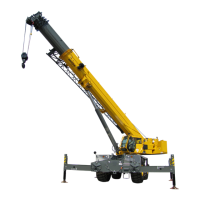5-2 Published 12-21-2011 CTRL #050-09
LUBRICATION PROCEDURE AND CHARTS 1300A OPERATOR’S MANUAL
conditions) need to have the exposed rods protected more
frequently by applying a protectant. Unless the machine is
operated daily, exposed rod surfaces will corrode. Some
cylinders will have rods exposed even when completely
retracted. Assume all cylinders have exposed rods, as
corrosion on the end of the rod can ruin the cylinder.
It is recommended that all exposed cylinder rods be
protected using Boeshield
®
T-9 Premium Metal Protectant.
Manitowoc Crane Care has Boeshield T-9 Premium Metal
Protectant available in 12 oz. cans that can be ordered
through the Parts Department.
NOTE: Cylinder operation and inclement weather will
remove the Boeshield protectant. Inspect
machines once a week and reapply Boeshield to
unprotected rods.
The following describe the lubrication points and gives the
lube type, lube interval, lube amount, and application of
each. Each lubrication point is numbered, and this number
corresponds to the index number shown on the Lubrication
Chart (Figure 5-1). Lube description and symbols are found
in tables below.
Hydraulic Oil Inspection
Environmental and other conditions can dramatically affect
the condition of hydraulic oil and filters. Therefore, specific
intervals for servicing/changing hydraulic oil, filters and
hydraulic tank breathers cannot be set. However, it is
imperative for the continued satisfactory performance that
inspections be performed on the basis of how and where
each crane is used. Air borne and ingested contaminants
can significantly reduce the life of oil and the condition of
hydraulic oil filters and tank breathers.
Under normal operating conditions, it is recommended that
hydraulic oil, filter and breathers be inspected at least every
three to six months and more frequently for severe operating
conditions. The inspections should be for air borne and/or
ingested particles and water that deteriorate and
contaminate the oil. For example, oil appears “milky” or no
longer has a transparent clear to amber color. The return
filter by-pass indicator should be observed daily to determine
if contaminant content is high. If the indicator reaches the red
zone or indicates a by-pass condition, the hydraulic oil must
be sampled. The hydraulic tank breather should also be
inspected to assure that it is not restricting air flow into and
out of the reservoir.
To inspect the hydraulic oil, fill a small glass container with a
sample of the reservoir oil and another glass container with
fresh oil. Let the samples stand, undisturbed, for one or two
hours. Then, compare the samples. If the reservoir oil is
heavily contaminated with water, the sample will appear
“milky” with only a small layer of transparent oil on top. If the
“milky” appearance is due to air foaming, it will dissipate and
the oil should closely match the fresh oil. Remember,
replacement oil must meet ISO 17/14 or better cleanliness
level and must meet John Deere Standard JDM J20C.
Contact your Product Support Representative if you have
any questions.
Standard Hydraulic Oil
Above 10°F (-12°C)
The factory fill standard hydraulic oil is SAE grade 10W-20
Hydraulic Oil. This fluid is acceptable for operating
temperatures above -12°C (10°F).
NOTE: On units equipped with self-leveling platforms, low
temperature service oils are necessary to provide
proper boom functions at temperatures below
+10°F (-12°C).
Intermediate Hydraulic Oil
(-10°F to 80°F) (-23°C to 27°C)
For colder operating environments, the standard fluid may be
replaced with a Low Service Temperature Multi Viscosity
Hydraulic Oil with High Viscosity index 175+.
Wide Range Intermediate Hydraulic Oil.
(-30°F to 80°F) (-34°C to 27°C)
For even colder operating conditions, the standard fluid may
be replaced with a petroleum based fluid developed
especially for colder environments.
Arctic Hydraulic Oil.
(-10°F and below) (-23°C and below)
In general, petroleum based fluids developed especially for
low temperature service may be used with satisfactory
results. However, certain fluids, such as hologenated
hydrocarbons, nitro hydrocabons and phosphate ester
hydraulic fluids might not be compatible with hydraulic
system seals and wear bands. Arctic hydraulic oil is not
recommended for service in ambient temperatures above
32°F (0°C).
If you are in doubt about the suitability of a specific fluid,
check with your authorized National Crane distributor or
Manitowoc Crane Care.
NOTE: All fluids and lubricants may be purchased by
contacting the Manitowoc Crane Care Parts
Department.
CAUTION
Operation of the crane with incorrect hydraulic oil in sub
freezing temperature (below 32°F, 0°C) can cause
damage to the extend cylinder.
Reference Only

